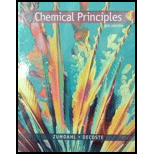
(a)
Interpretation:
The value of
Concept Introduction:
The mathematical expression for the standard entropy value at room temperature is:
Where, n and p represents the coefficients of reactants and products in the balanced chemical equation.
The mathematical expression for the standard enthalpy change value at room temperature is:
Where, n and p represents the coefficients of reactants and products in the balanced chemical equation.
Spontaneity depends upon the temperature and also depends upon the sign of free energy change.
The mathematical expression for
If both
When the magnitude of
Therefore, reaction is non- spontaneous at low temperature and spontaneous at high temperature.
(a)
Answer to Problem 2E
Explanation of Solution
The given reaction is:
The value of standard entropy for
The value of standard entropy for
The value of standard entropy for
The value of standard entropy for
Put the values, in below formula.
The value of standard enthalpy for
The value of standard enthalpy for
The value of standard enthalpy for
The value of standard enthalpy for
Put the values, in below formula.
(b)
Interpretation:
The temperature which favor the formation of product should be determined by considering standard conditions and,
Concept Introduction:
The mathematical expression for the standard entropy value at room temperature is:
Where, n and p represents the coefficients of reactants and products in the balanced chemical equation.
The mathematical expression for the standard enthalpy change value at room temperature is:
Where, n and p represents the coefficients of reactants and products in the balanced chemical equation.
Spontaneity depends upon the temperature and also depends upon the sign of free energy change.
The mathematical expression for
If both
When the magnitude of
Therefore, reaction is non- spontaneous at low temperature and spontaneous at high temperature.
(b)
Answer to Problem 2E
The temperature which favors the formation of product is
Explanation of Solution
The given reaction is:
From part (a):
Here, sign of
Put the values,
Now,
Let
Since, 1 Kilojoule = 1000 Joule
The process is spontaneous when
Want to see more full solutions like this?
Chapter 18 Solutions
CHEM.PRINC.W/OWL2+REBATE+2 SUPPL.>IP<
- Using values of fH and S, calculate the standard molar free energy of formation, fG, for each of the following: (a) Ca(OH)2(s) (b) Cl(g) (c) Na2CO3(s) Compare your calculated values of fG with those listed in Appendix L. Which of these formation reactions are predicted to be product-favored at equilibrium at 25 C?arrow_forwardConsider the reaction: H2S(g)+SO2(g)3S(g)+2H2O(l) for which H is 233 kJ and S is 424 J/K. a. Calculate the free energy change for the reaction (G) at 393 K. b. Assuming H and S do not depend on temperature, at what temperatures is this reaction spontaneous?arrow_forwardThe Ostwald process for the commercial production of nitric acid involves three steps: 4NH3(g)+5O2(g)825CPt4NO(g)+6H2O(g)2NO(g)+O2(g)2NO2(g)3NO2(g)+H2O(l)2HNO3(l)+NO(g) a. Calculate H, S,G and K (at 298 K) for each of the three steps in the Ostwald process (see Appendix 4). b. Calculate the equilibrium constant for the first step at 825C, assuming H and S do not depend on temperature. c. Is there a thermodynamic reason for the high temperature in the first step, assuming standard conditions?arrow_forward
- Consider the reaction Fe2O3(s)+3H2(g)2Fe(s)+3H2O(g) a. Use Gf values in Appendix 4 to calculate G for this reaction. b. Is this reaction spontaneous under standard conditions at 298 K? c. The value of H for this reaction is 100. kJ. At what temperatures is this reaction spontaneous at standard conditions? Assume that H and S do not depend on temperature.arrow_forwarda Calculate K1, at 25C for sulfurous acid: H2SO3(aq)H+(aq)+HSO3(aq) b Which thermodynamic factor is the most significant in accounting for the fact that sulfurous acid is a weak acid? Why?arrow_forwardUsing values of fH and S, calculate rG for each of the following reactions at 25 C. (a) 2 Na(s) + 2 H2O() 2 NaOH(aq) + H2(g) (b) 6 C(graphite) + 3 H2(g) C6H6() Which of these reactions is (are) predicted to be product-favored at equilibrium? Are the reactions enthalpy- or entropy-driven?arrow_forward
- The major industrial use of hydrogen is in the production of ammonia by the Haber process: 3H2(g)+N2(g)2NH3(g) a. Using data from Appendix 4, calculate H, S, and G for the Haber process reaction. b. Is the reaction spontaneous at standard conditions? c. At what temperatures is the reaction spontaneous at standard conditions? Assume H and S do not depend on temperature.arrow_forwardThe free energy of formation of one mole of compound refers to a particular chemical equation. For each of the following, write that equation. a KBr(s) b CH3Cl(l) c H2S(g) d AsH3(g)arrow_forwardUsing values of fH and S, calculate rG for each of the following reactions at 25 C. (a) 2 Pb(s) + O2(g) 2 PbO(s) (b) NH3(g) + HNO3(aq) NH4NO3(aq) Which of these reactions is (are) predicted to be product-favored at equilibrium? Are the reactions enthalpy- or entropy-driven?arrow_forward
 Chemistry: An Atoms First ApproachChemistryISBN:9781305079243Author:Steven S. Zumdahl, Susan A. ZumdahlPublisher:Cengage Learning
Chemistry: An Atoms First ApproachChemistryISBN:9781305079243Author:Steven S. Zumdahl, Susan A. ZumdahlPublisher:Cengage Learning ChemistryChemistryISBN:9781305957404Author:Steven S. Zumdahl, Susan A. Zumdahl, Donald J. DeCostePublisher:Cengage Learning
ChemistryChemistryISBN:9781305957404Author:Steven S. Zumdahl, Susan A. Zumdahl, Donald J. DeCostePublisher:Cengage Learning
 Chemistry & Chemical ReactivityChemistryISBN:9781133949640Author:John C. Kotz, Paul M. Treichel, John Townsend, David TreichelPublisher:Cengage Learning
Chemistry & Chemical ReactivityChemistryISBN:9781133949640Author:John C. Kotz, Paul M. Treichel, John Townsend, David TreichelPublisher:Cengage Learning Chemistry & Chemical ReactivityChemistryISBN:9781337399074Author:John C. Kotz, Paul M. Treichel, John Townsend, David TreichelPublisher:Cengage Learning
Chemistry & Chemical ReactivityChemistryISBN:9781337399074Author:John C. Kotz, Paul M. Treichel, John Townsend, David TreichelPublisher:Cengage Learning Chemistry: The Molecular ScienceChemistryISBN:9781285199047Author:John W. Moore, Conrad L. StanitskiPublisher:Cengage Learning
Chemistry: The Molecular ScienceChemistryISBN:9781285199047Author:John W. Moore, Conrad L. StanitskiPublisher:Cengage Learning





